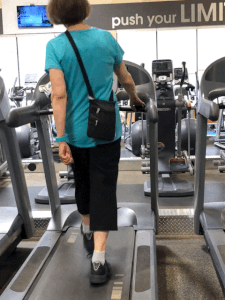
Just take that hand off the front bar or side rail already; otherwise it makes your body work unevenly, plus numerous other problems.
Look at the woman above holding onto the treadmill with one hand. She was not modeling this; she was an actual gym user doing her “workout.”
You need not be a spine doctor to immediately see how bad this is for her vertebral column and the soft tissue that it’s part of. Her ENTIRE GAIT is thrown off whack.
This is a very unnatural way to walk. You might be thinking, “She appears older; maybe it’s better for her to walk with one hand on the treadmill.”
However, being older or new to the treadmill is ALL THE MORE REASON to walk naturally: arms swinging at your sides in harmony with the movement of your lower body.
The one-hand approach is a bad habit. Ask yourself why you feel it’s mandatory to do this. The purpose of a treadmill is to simulate walking.
Though some will argue that walking on a moving tread hardly simulates “real” walking, training on a treadmill without holding onto it actually does a good job of carrying over to “real” walking (or running).
The one-hand hold provides stabilization to the body that the body doesn’t have to be accountable for.
And when you venture outside, you’re not holding onto anything. Stabilization, then, must come from YOU.
If you’ve taught your body to depend on that one hand holding onto the treadmill, you have caused your body to regress, not progress.
Why do people hold onto a treadmill with one hand?

Typically, they switch hands every so often during their walk or jog. One person told me she gets dizzy. The most common reason seems to be that people think they’ll lose their balance.
This includes the strapping burly man in the image above. This is not a model posing.
He was caught actually holding onto the front bar with one hand during his entire walk.
Can we really believe this muscular dude had a balance disorder? He had no problem going up the flight of stairs after his fake walking workout.
So then, WHY was he, and all the ohters like him, holding on with one hand?
Because he’s MENTALLY not ready to do the extra work it requires to walk wtihout holding on.
This is akin to stopping at 10 pushups when you know you can do 15, or curling 20 pound dumbbells for eight reps when you know you can do 25 pounds for eight reps. It’s psychological laziness.
Is it really believable that the burly guy TRULY FEARED he’d topple off the tread if he let that one hand go? Come ON, people.
Why is one hand on a treadmill a bad thing?
By keeping one hand on a treadmill, you will create an uneven gait pattern, even if you switch hands and give each hand equal time on the rails or bar.
Switching hands doesn’t matter because while you’re walking with that one hand on the bar or rail, here’s what’s happening:
Your hips are moving unevenly. One side of your upper body is locked up while the other side is moving.
The hip on the side of the hand that’s holding on is overcompensating to make up for the immobilized upper body on that same side.
Meanwhile, the other hip is trying to match the motion of the overcompensating one. This imbalance does NOT get offset by switching hands.
Holding on with one hand creates a ripple effect of skewered gait mechanics that begins at the shoulder and goes all the way down to the foot.
“Changing of the gait can always lead to injuries, especially soft tissue injuries such as tendinitis,” says Dr. Oliver Zong, DPM, a foot specialist and surgeon based in New York.
“To the extent that holding on to the treadmill changes one’s gait, this could happen. Clearly it is better to walk or run naturally with a natural gait pattern.”
The net effect of holding onto a treadmill with one hand, even if they’re switched, is an increased risk of repetitive stress injuries in the shoulder, hip, low back and foot.
Even if you don’t get an RSI, you’ll fail to train your body to be more efficient at balance and coordination.
In fact, you’ll “de-train” it by making it more dependent upon external support (the bar or rail).
This will not translate to real-world movement and will actually make you less efficient in the real world of uneven surfaces, steps, puddles to step over, etc.
- Next time you’re on a treadmill, ditch the one-hand approach and walk the natural way.
- Swing the arms rhythmically as the rest of your body moves.
- If you fear losing your balance, use a slower speed and then progress from there.
Holding onto a treadmill with one hand will cause a deficit in your ability to balance and coordinate your movements in the real world.












